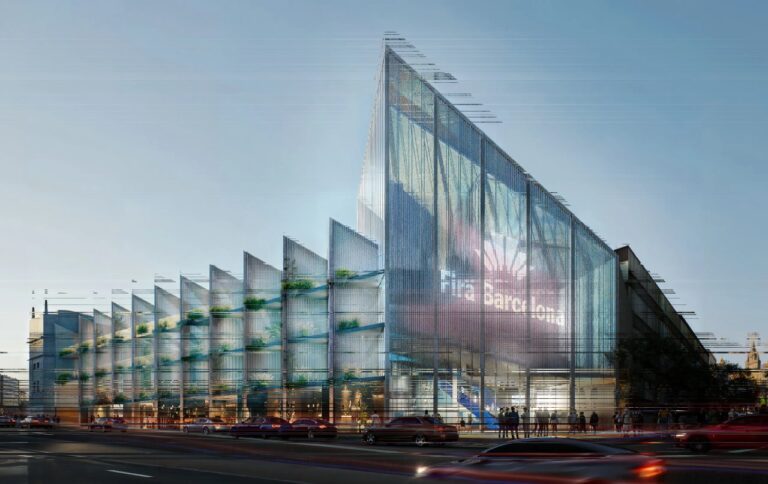The future Montjuïc venue in Barcelona is starting to take shape through the designs of the winning teams of the architectural competition, announced during the March meeting of the Commission for the Centenary of the 1929 International Exposition. Three unique monumental halls – sustainable, avant-garde, and blending modernity with historical surroundings – will define the first phase of the renovation of this iconic city landmark. Management says the goal is to transform the venue into a cutting-edge urban exhibition space for the 21st century.
The Commission for the Centenary, comprised by the Barcelona City Council, the Government of Catalonia and Fira de Barcelona, released some of the design renders of the winning architectural projects for these first three major renovations within the Montjuïc venue at a press conference 17 March. The winners were selected by a jury made up of five experts and chaired by the architect Josep Lluís Mateo. Key criteria included modernizing the trade show facilities under parameters of efficiency, digitalisation and sustainability.
Attending the press conference were the Mayor of Barcelona, Jaume Collboni; the minister of industry and tourism of Spain, Jordi Hereu; the minister of economy of the government of Catalonia, Alícia Romero; the president of the Board of Directors of Fira de Barcelona, Pau Relat; the general manager of Fira, Constantí Serrallonga; and the architect in chief of the Barcelona City Council, Maria Buhigas.
New Multifunctional Hall
The winner of the first lot, aimed at the construction of the Multifunctional Hall and the renovation of the current Palau de les Comunicacions, is the architect team of Smiljan Radić, Miquel Mariné Núñez, Beatriz Borque and Cesar Rueda Bonet whose proposal 2029 Artefacto traces a luminous and monumental complex that is committed to transparency and to liberating the facades through a light metal structure, which provides the complex with permeability to achieve an integration of the new pavilion with the urban environment.
The Multifunctional Hall, built on the current site of the Palau de Congressos de Barcelona and Hall 4, will consist of a large two-storey building with a total of 20,500sqm of exhibition space and is designed to host all kinds of events. The project includes the creation of a large landscaped walkway of more than 2,000sqm that joins the two pavilions on the façade of Avenida Maria Cristina.
This first lot also includes the architectural preliminary project for the renovation of the Palau de les Comunicacions (Hall 1), which will be developed in a second phase, to ensure an aesthetic link and continuity between the two buildings.
Past and sustainable future combined
The design chosen in the second lot, which encompasses the construction of the new Palau de Congressos de Barcelona in the current Palau Alfons XIII, was the one presented by Forgas Architectes, Archambac (Arquitectura Sideral) and Álvaro Alejandro Fernández. Under the theme Umbracle, the proposal outlines a large open-plan and flexible space that gives prominence to natural light. The project is committed to respecting as much as possible the current structure of the hall designed by Josep Puig i Cadafalch to create a set of spaces that include a new access from Plaça de Carles Büigas through a lobby and a courtyard-garden of 6,670sqm, an exhibition hall of 3,132sqm, a large auditorium with capacity for 2,025 people, as well as several multipurpose and meeting rooms.
The new building would be self-sufficient from an energy point of view thanks to the reduction of consumption through high-efficiency installations and energy production through photovoltaic, aerothermal and geothermal systems. In addition, the facility will also have a stormwater collection deposit.
Fira’s new entryway
Finally, the winner of the third lot, focused on the renovation of the Palau del Vestit to house the Fira Barcelona Innovation Hub, the future permanent innovation centre of the trade show institution, was the team formed by Bjarke Ingels Group and MIAS Arquitectura, whose proposal titled L’Avantsala de la Fira proposes the construction of a functional and flexible three-storey building in the shape of a ‘Z’ surrounded by a public garden. The current façade of Plaza España and its set of columns will become an entrance portico to the gardens.
Work on this first phase will start at the beginning of 2026 and will be completed in 2029, coinciding with the celebration of the centenary of the 1929 International Expo. The planned investment is €255m, of which €215m will be allocated, through Fira 2000, to the construction of the new Multifunctional Hall and Palau de Congressos de Barcelona, and €40m for the works on the Palau del Vestit by Fira de Barcelona.
In a second phase of this project to refurbish the exhibition space, a new architectural competition will be launched for the executive project for the remodelling of the Palacio de las Comunicaciones – Palau 1 and for the Palacio de la Metalurgia – Palau 8. Trade fair activities will continue throughout the renovation.
A Centenary of the 1929 International Exposition: BCN2029 consortium, made up of the Government of Catalonia, Barcelona City Council and Fira de Barcelona, which will be in charge of the management of all actions and activities framed in the commemoration of the centenary.
The Commission will be committed to recovering the spirit of the 1929 International Exposition based on science, knowledge, culture and innovation as tools to respond to the future challenges of Europe and cities, with a special focus on the climate crisis.
Source: www.exhibitionworld.co.uk


Comments are closed.